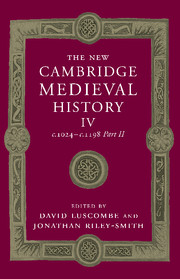Book contents
- Frontmatter
- 1 Introduction
- 2 The papacy, 1024–1122
- 3 The western empire under the Salians
- 4 Italy in the eleventh century
- 5 The kingdom of the Franks to 1108
- 6 Spain in the eleventh century
- 7 England and Normandy 1042–1137
- 8 The Byzantine Empire, 1025–1118
- 9 Kievan Rus’, the Bulgars and the southern Slavs, c. 1020 – c. 1200
- 10 Poland in the eleventh and twelfth centuries
- 11 Scandinavia in the Eleventh and Twelfth Centuries
- 12 Hungary in the Eleventh and Twelfth Centuries
- 13 The papacy, 1122–1198
- 14 The western empire, 1125–1197
- 15 Italy in the twelfth century
- 16 Spain in the twelfth century
- 17 The kingdom of the Franks from Louis VI to Philip II
- 18 England and the Angevin dominions, 1137–1204
- 19 Scotland, Wales and Ireland in the Twelfth Century
- 20 The Byzantine Empire, 1118–1204
- 21 The Latin East, 1098–1205
- 22 ’Abbasids, Fatimids and Seljuqs
- 23 Zengids, Ayyubids and Seljuqs
- Appendix: genealogical tables
- List of primary sources
- Bibliography of Secondary Works Arranged by Chapter
- Index
- Map 1a The western empire: Burgundy and Provence in the eleventh century"
- Map 1b The western empire: Germany and the north-eastern frontier of Christendom in the eleventh century"
- Map 3 The kingdom of the Franks"
- Map 4 England and Normandy"
- Map 10 Germany under Frederick Barbarossa, c. 1190">
- Map 12 The Angevin empire"
- References
2 - The papacy, 1024–1122
Published online by Cambridge University Press: 28 March 2008
- Frontmatter
- 1 Introduction
- 2 The papacy, 1024–1122
- 3 The western empire under the Salians
- 4 Italy in the eleventh century
- 5 The kingdom of the Franks to 1108
- 6 Spain in the eleventh century
- 7 England and Normandy 1042–1137
- 8 The Byzantine Empire, 1025–1118
- 9 Kievan Rus’, the Bulgars and the southern Slavs, c. 1020 – c. 1200
- 10 Poland in the eleventh and twelfth centuries
- 11 Scandinavia in the Eleventh and Twelfth Centuries
- 12 Hungary in the Eleventh and Twelfth Centuries
- 13 The papacy, 1122–1198
- 14 The western empire, 1125–1197
- 15 Italy in the twelfth century
- 16 Spain in the twelfth century
- 17 The kingdom of the Franks from Louis VI to Philip II
- 18 England and the Angevin dominions, 1137–1204
- 19 Scotland, Wales and Ireland in the Twelfth Century
- 20 The Byzantine Empire, 1118–1204
- 21 The Latin East, 1098–1205
- 22 ’Abbasids, Fatimids and Seljuqs
- 23 Zengids, Ayyubids and Seljuqs
- Appendix: genealogical tables
- List of primary sources
- Bibliography of Secondary Works Arranged by Chapter
- Index
- Map 1a The western empire: Burgundy and Provence in the eleventh century"
- Map 1b The western empire: Germany and the north-eastern frontier of Christendom in the eleventh century"
- Map 3 The kingdom of the Franks"
- Map 4 England and Normandy"
- Map 10 Germany under Frederick Barbarossa, c. 1190">
- Map 12 The Angevin empire"
- References
Summary
INTRODUCTION
General
The author of a chapter on the history of the papacy from 1024 to1122 confronts the unusual task of giving in a few pages an account of both the Adelspapsttum and of the popes of the Gregorian reform period. No greater contrast could be imagined, one might think. After the clean-sweep of Sutri and Rome in 1046, when ecclesiastical councils under the guidance of Emperor Henry III cleared the way for the first of the northern newcomers, Pope Clement II (1046–7), a fundamentally altered papacy is supposed to have arisen from the ashes of a papacy dominated by the corrupt local Roman nobility. And, indeed, profound changes occurred in the second half of the eleventh century, although with regard less to the papacy itself as an institution than to its relationship with the churches of the empire (Germany, Italy and, at times, Burgundy), the Normans of Italy, the principalities and kingdom of France and the Byzantine patriarchate. Because of the Conquest and the special relationship between the papacy and the English kings from William I to Henry I, England stood somewhat apart in this reordering, as did Spain on account of the Reconquista. It involved the successful realization of the papal primacy. This was not limited to the secular realm, but also deeply affected relationships within the church. The history of these changes can be found in an earlier chapter as well as in many handbooks and will only be sketched very briefly here. The present chapter will emphasize the administrative underpinning that allowed a strengthened papacy to emerge at the end of the twelfth century under Innocent III (1198–1216) as the single most influential political and spiritual institution of Latin Christendom.
Keywords
- Type
- Chapter
- Information
- The New Cambridge Medieval History , pp. 8 - 37Publisher: Cambridge University PressPrint publication year: 2004
References
- 2
- Cited by

